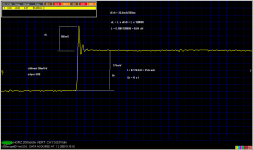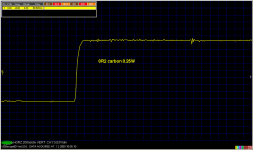The resistor distortion graphs are from a Radiometer Copenhagen CLT-1. They are an indication of 3rd harmonic of a 10 KHz fundamental. Its a pretty sensitive test and shows construction issues. I use one to evaluate pots resistors caps and other stuff.
Hi Demian,
We are left with which resistors to use for attenuators, make, model and values …
We are left with which resistors to use for attenuators, make, model and values …
john curl said:It is not for lack of trying. I never heard of them before, and I don't see, at this time, how they would make a BETTER attenuator than what we already know how to do.
Coming from you, this statement sounds funny 😀
1audio said:The resistor distortion graphs are from a Radiometer Copenhagen CLT-1. They are an indication of 3rd harmonic of a 10 KHz fundamental. Its a pretty sensitive test and shows construction issues. I use one to evaluate pots resistors caps and other stuff.
Without a reference level those plots are meaningless. What I mean to say is that we have built circuits with SMT 10 Meg resistors that are easily better than .03% linearity but maybe not at 500V p-p.
john curl said:
We, as engineers and physicists, TRY to find a plausible mechanism for the differences, but we are only giving the best guess that we can come up with. The differences are still there, even if we can't prove them to everyone's satisfaction.
Though repeatedly the "hear a difference" crowd (re: speaker cables) does not even have the slightest interest in measuring simple frequency response deviations.
The best I have heard was probably a product of all the equipment together, a classic 1980's Absolute Sound setup with Koetsu,Goldmund, Conrad Johnson, Infinity, etc. The guy had NOTHING but old RCA and Mercury LP's.
Then you're way out of the loop as far as what high end has to offer. Things are better these days and not by a little bit. Even vinyl has gotten a lot better - I personally can't stand vintage Mercury LPs. Modern re-mastered discs from the likes of SpeakersCorner are far better.
Though repeatedly the "hear a difference" crowd (re: speaker cables) does not even have the slightest interest in measuring simple frequency response deviations.
Measurements only point out grotesque errors and help out troubleshooting. A successful audio product should always be voiced by ear. If you get used to listening to an excellent, modern high-end system you will "hear the difference" in changes to the system that you won't believe because of the apparent absurdity of the thing. Unless of course you don't have acute hearing AND you aren't a trained listener. That's another topic in itself that doesn't really get enough serious discussion.
John
scott wurcer said:
Without a reference level those plots are meaningless. What I mean to say is that we have built circuits with SMT 10 Meg resistors that are easily better than .03% linearity but maybe not at 500V p-p.
I'm not sure what you are saying or asking. I would guess that the measurements plotted are at the rated power of the resistors. -140 dB is less than .03%. 500V across a smt 10Meg resistor would require a pretty large one physically, especially at higher frequencies.
I have not seem much talk about voltage coefficient, the real accuracy limiter for high voltage applications.
jlsem said:
A successful audio product should always be voiced by ear.
John
Not all successful products are voiced by ear the Duntech "Sovereign" was a very successful product that was not voiced by ears.
My I ask what you consider a successful speakers for reference purposes .
Regards
Arthur
I don't think everything always has to be 'voiced' by ear, but it can help, sometimes. For many years, I relied on measurements, both normal and exotic, and still did pretty well. Then I built a power amp that my associates found wanting, subjectively, yet it measured very well. I learned then, that measurements are not everything. I have found that it is avoiding certain passive parts is what makes the most difference, for my designs.
john curl said:I don't think everything always has to be 'voiced' by ear, but it can help, sometimes. For many years, I relied on measurements, both normal and exotic, and still did pretty well. Then I built a power amp that my associates found wanting, subjectively, yet it measured very well. I learned then, that measurements are not everything. I have found that it is avoiding certain passive parts is what makes the most difference, for my designs.
Hello John,
With things that I build I have found that unless you use a proper full range monitoring speaker which is set up properly that you are waisting your time when it comes to evaluation. By proper full range monitor I mean a minimum of a 3 way speaker, bass driver , mid range and tweeter, anything less than this is not good enough for evaluating a product that needs to sound good on most systems. I dont think that two way speakers cut the mustard for evaluation purposes, and its very easy to be fooled into thinking your product sounds good only to find it does not translate the same way into other peoples systems.
With full range speakers you can here things that you cannot possible here on a two way speaker , because it is more revealing.
By the way I agree with you on the impact that passives have on the sound of amplifiers.
Regards
Arthur
I would like to know what kind (technology, manufacturer) of Re emitter resistors in power output stages are recommended (0.1R - 0.22R values). IMO they make a big difference. Their inductance contributes to stability/instability in a high degree, as well as PCB tracks to/from them.
PMA said:I would like to know what kind (technology, manufacturer) of Re emitter resistors in power output stages are recommended (0.1R - 0.22R values). IMO they make a big difference. Their inductance contributes to stability/instability in a high degree, as well as PCB tracks to/from them.
I did measure some power resistors in the past - many have very measurable distortion at 1 A current level (0.01-0.1%). I don't have results now - perhaps one day I will repeat my experiment.
Alex
PMA said:I would like to know what kind (technology, manufacturer) of Re emitter resistors in power output stages are recommended (0.1R - 0.22R values). IMO they make a big difference. Their inductance contributes to stability/instability in a high degree, as well as PCB tracks to/from them.
I have always had best results with non-inductive diy wirewounds using nice copper wire.
Attachments
PMA said:
PMA,
These *may* be interesting curves, but I have no idea what it is, how it is measured, etc, so at this point it isn't very usefull.
Jan Didden
- Status
- Not open for further replies.
- Home
- Amplifiers
- Solid State
- John Curl's Blowtorch preamplifier

